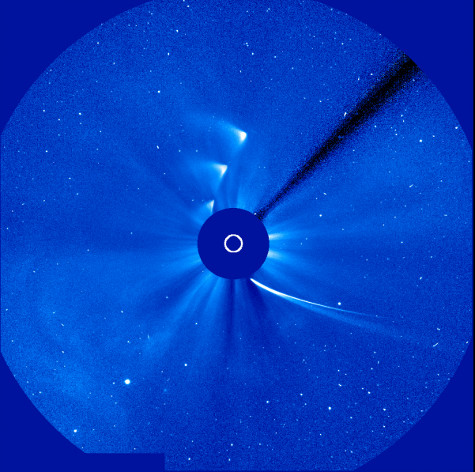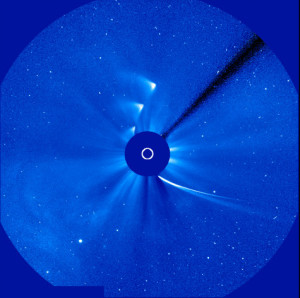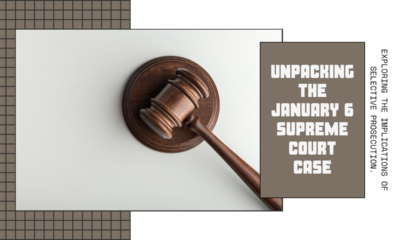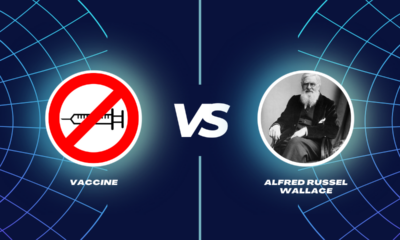Creation Corner
Comet ISON is alive – and has come back

Comet C/2012 S1, which astronomers also call Comet ISON, did not die after its close pass at the Sun two days ago. (Source: ABC News) Yesterday morning (Friday 29 November 2012) at 8:11 a.m. EST, an object appeared near the Sun on Comet ISON’s course track. ( Sources: CNN, ABC, Huffington Post) It grew a tail and already has a corona 1000 times the diameter of Earth. So Comet ISON has almost surely passed the Sun. It broke into a few large pieces instead of thousands of little pieces.
But more important than that, Comet ISON has been here before. A retired engineer notes that Comet ISON followed almost the same orbit as Comet C/1680 V1, the Great Comet of 1680. He told CNAV this afternoon, in no uncertain terms: Comet ISON and the Great Comet of 1680 are the same comet.
Comet ISON and its course track

This time-lapse image shows Comet ISON approaching and leaving during its slingshot around the sun – represented by the white circle — on Nov. 28, 2013. The ISON images clearly outline the curve of the comet’s orbit path. Images from SOHO.Photo courtesy of ESA/NASA/SOHO/SDO/GSFC
Comet ISON takes its name from the International Scientific Observation Network. It is one of several comets the ISON group observed and numbered. This particular comet, C/2012 S1, excited the ISON group members for an important reason, according to NASA: it seems to have come in on a hyperbolic orbit.
An object on a hyperbolic orbit would fall in toward the Sun, pass around it, leave the solar system, and never come back.
No astronomers have ever seen a comet fall in toward the Sun on a hyperbolic path. This fact has vexed astronomers who champion the favorite theory to explain where comets came from. In 1952, Jan Oort proposed that all comets come from a spherical “cloud of comets” that orbits the Sun as far out as fifty thousand times the distance from the Earth to the Sun. (That’s fifty thousand astronomical units.) A passing star perturbs the cloud and sends a comet or two falling in. So says the theory. (The only star that could do this would be Proxima, or Alpha Centauri C. Even that is too far away. But we digress.)
That no comet has ever fallen in on a hyperbolic track, is a deal-killer for the Oort cloud theory. Walter T. Brown of Phoenix, Arizona, points this out in his book, In the Beginning: Compelling Evidence for Creation and the Flood.
If passing stars or other gravitational disturbances “shake” comets from an Oort cloud, some of those comets should have obvious hyperbolic orbits as they enter the planetary region. None have been reported, so there is probably no Oort cloud.
This is true whether one believes the Oort cloud formed well beyond the solar system, or formed at its edge, only to have the gas giants sling them further out.
But Comet ISON is on a hyperbolic track. In fact, Comet ISON’s track seems to be hyperbolic beyond twelve standard deviations. If that holds, then Comet ISON came in from beyond the solar system, from even further away than 50,000 AU.
Or did it? Brown points out something NASA and every reporter on Comet ISON overlooks. No one really knows how heavy the solar system is. If the solar system is less than one percent heavier than people think, a comet like ISON does not even feel the full effect of its gravity until it is much further away. So Comet ISON, and any of a number of other “near parabolic comets,” can still follow a closed path. We simply wouldn’t see the far end of that path. And at the time of this writing, Comet ISON feels only the gravity of the Sun and not the gravity of any of the planets, satellites, or asteroids! (Reason: an object closer to the primary than other objects in orbit cannot feel the gravity of those other objects. Not until its own course track takes it outside their orbits again.)
One other reason makes a hyperbolic course track less likely. How could a comet, on a hyperbolic track, pass close enough to the Sun almost to skim its surface, and risk disintegration and death? That would be like shooting an arrow from Proxima (see above), or even Tau Ceti, and grazing the bulls-eye!
So if Comet ISON follows a closed path, then it is simply a long-period comet. And it almost surely has been near the Sun and the Earth before.
The Great Comet of 1680
On 30 November 1680, Comet C/1680 V1 passed within 0.0062 AU of the sun. (Brown describes this comet on this page.) On 29 December 1680 it became the brightest object in the sky. It was so bright that Europeans could see it in the daytime. Sir Isaac Newton saw it and developed his theory of gravitation in part by watching it move.
The problem: Comet ISON is following almost the same track as did Comet C/1680 V1. The chances that any two comets would follow orbits that are any closer than those of Comet ISON and C/1680 V1 are six thousandths of one percent. That is statistically significant, meaning it didn’t “just happen that way.” Those two comets follow the same course track for a reason.
What can that reason be? Either Comet ISON and the 1680 Comet are the same comet, or Comet ISON is a big piece of Comet 1680 that fell back to the Sun sooner than did the main mass. At least one amateur astronomer believes the latter. But where’s the rest of the 1680 comet in that case?
Brown explains it this way (and explained it again to CNAV): Comet C/1680 V1 sailed out beyond the furthest objects in the solar system after making its spectacular pass. In so doing, it came under the influence of all the Trans-Neptunian Objects.
They’re discovering new Trans-Neptunian Objects every week, it seems. [And] the distribution of the mass matters. If it’s a shell, you need more mass to pull the comet back in. If it’s a disk, you need less, because more of that mass will pull it in as it passes it.
So: we don’t know how massive the solar system it. And if Comet ISON is the same as Comet C/1680 V1, then the period of that comet is 333 years. So before 1680, it was probably another unrecognized event during the Hundred Years War in Europe. Before that it was an unnoticed or unrecorded event in the era of the Crusades. Perhaps the Chinese have a record of it, but no one has yet discovered or interpreted it properly.
Terry A. Hurlbut has been a student of politics, philosophy, and science for more than 35 years. He is a graduate of Yale College and has served as a physician-level laboratory administrator in a 250-bed community hospital. He also is a serious student of the Bible, is conversant in its two primary original languages, and has followed the creation-science movement closely since 1993.
-

 Executive1 day ago
Executive1 day agoJanuary 6 case comes down to selective prosecution
-

 News1 day ago
News1 day agoRolling the Dice on Republicans: Has the Right Become Delusional?
-

 Civilization1 day ago
Civilization1 day agoBiology, the Supreme Court, and truth
-

 Executive9 hours ago
Executive9 hours agoWhy Fatal Police Shootings Aren’t Declining: Some Uncomfortable Facts
-

 Civilization7 hours ago
Civilization7 hours agoPresident Biden Must Not Encourage Illegal Mass Migration From Haiti
-

 Entertainment Today10 hours ago
Entertainment Today10 hours agoWaste of the Day: Throwback Thursday: Millions Went To Video Game ‘Research’
-

 Guest Columns7 hours ago
Guest Columns7 hours agoWhat Was Won in No Labels’ Crusade
-

 Constitution8 hours ago
Constitution8 hours agoEquality Under the Law and Conflicts of Interest in New York















[…] Reprinted from Conservative News and Views […]
Oh my. Where to begin?
Dr. Brown wishes to make the solar system ~1% more massive so that ISON will no longer be hyperbolic. He needs to have this extra mass distributed in a hollow sphere around the observable solar system so that ISON only ‘feels’ its pull when it is out beyond the spherical shell, and not while inside it, and also so that the orbits of the known planets are not noticeably perturbed. 1% of the mass of the solar system would represent about 10 times the combined mass of all the moons and planets, or about 3000 times the mass of Earth. The Oort cloud that Dr. Brown dismisses is theorized to have a total mass of somewhere between 5 and 100 Earth masses. So Dr. Brown wishes to replace the unobserved Oort cloud with an unobserved cloud having up to 600 times _more_ mass in it – and yet the Oort cloud is supposed to be the fantastic claim?
At the time of this writing, ISON most definitely feels the pull of gravity of all of “the planets, satellites, or asteroids”. These effects are of course swamped by the pull from the Sun – inverse square law and all that – but the pull from the other masses in the solar system does not stop when the comet is inside their respective orbits. The Moon doesn’t fly off into space when it passes between Earth and the Sun, does it? The phenomenon that you are claiming only applies to the interiors of hollow spherical shells of matter, not to orbiting planets.
As for hitting bullseyes from Proxima Centauri, it’s not surprising that objects moving toward the solar system are attracted toward the spot where 99.6% of the mass in the solar system is located. ISON is behaving almost exactly as it would if it was in free fall toward the solar system from a large distance away.
If this is the comet of 1680, it’s coming back about nine _thousand_ years earlier than expected. How much mass does Dr. Brown have to put out beyond the solar system to cause that comet, or a portion of it, to perform such an abrupt about-face? Does Dr. Brown find it less unlikely that a random flyby of a massive trans-Neptune object caused all or a portion of the 1680 comet to whip around and come back into the solar system along approximately the same track that it followed initially (when it should be about 200 AU out at the moment)? Forget bullseyes from Tau Ceti – this is like shooting a bullet at the sky and having it ricochet off a falling meteor and come screaming back straight down the barrel of your gun!
First:
Not necessarily a hollow sphere. A ring will do. Or more likely a disk. The Scattered Disk.
Did no one tell you that when you’re inside a distributed formation of matter that surrounds you completely, whether you are at the center or not, you can feel no gravitational pull from that matter? If the Earth were somehow pellucid, and you dropped into the pellucid cavity, you would float. Gravitational attraction cancels out in that region. Get beyond that region, and that no longer holds. The gravitational attraction on any orbiting body depends on the mass closer to the barycenter of the system. Anything further away might as well not be there.
ISON cannot feel anything but the Sun pulling on it. And as massive as the Sun is, the masses of all those planets that it is “inside” is not negligible.
And of course Comet C/1680 V1 is coming back sooner than expected. Sooner than expected if we have the hubris to declare we have discovered every discoverable trans-Neptunian object, and the further hubris to ignore the “inside-outside” problem I described above.
And I’ll take my target problem over yours any day, as a candidate for the more difficult one.
A scattered disk of uniform density, or even a fat torus, exerts a net gravitational attraction toward the plane of the disk/torus. If you are above that plane, it pulls you down; below, and it pulls you up. This is true even if there is a hole in the center of the disk and you are at or in that hole. In fact, as the size of the disk increases the force of gravity pulling down to the disk no longer falls off as the square of distance to the disk, but approaches a constant value regardless of distance (google gravity of an infinite plane if you don’t believe me).
The point remains though that Dr. Brown wants to put 3000X the mass of Earth in some distribution beyond the visible solar system as an alternative to the Oort cloud’s 5-100 Earth masses, and the only way to do that that produces no net gravitational force unless you are ‘outside’ the distribution is a spherical shell. Not solid, necessarily; a swarm of objects would work if the average density were constant. But that looks a lot like a supermassive Oort cloud, doesn’t it?
No, nobody ever told me that “when you’re inside a distributed formation of matter that surrounds you completely, whether you are at the center or not, you can feel no gravitational pull from that matter”, because that’s not true. For the specific case of a spherical shell of uniform density, it is true that you feel no _net_ gravitational force, yes. But that is because of the particular shape of the mass distribution – the force vectors all cancel out leaving no net force. But that is not true for point masses orbiting in a plane, or indeed any other distribution of mass that is not spherically symmetric. And it’s never true that you feel no gravitational pull from the matter; gravitational attraction propagates to infinite distances although it falls off as square of distance.
If the Earth were pellucid, you could see through it clearly, because pellucid means transparent. If it were _hollow_, on the other hand, yes you could float in its interior with no _net_ gravitational attraction in any direction, assuming the density of the shell was uniform and there was no Moon or Sun exerting a pull from outside the sphere. Of course, with the Moon in orbit you would be dragged in a spiraling path toward the point on the inside of the shell closest to the Moon. Seriously, what do you think keeps the Moon in orbit around Earth when the Moon passes between Earth and the Sun? Where do you think the barycenter of the Earth-Moon-Sun system lies?
ISON feels the pull of the Sun, and the pull of Mercury, Venus, Earth, the Moon, Mars, etc. etc. The Sun’s pull is the strongest at the moment, because it has >99% of the mass in the Solar System, and ISON is much closer to it than to any other body right now. But ISON still feels the pull of, say, Jupiter, whether it is inside Jupiter’s orbit or outside it. The force falls off as the square of the distance to Jupiter, but it never goes to zero as long as ISON isn’t sitting at Jupiters center.
If you want 1680 to come back 9000 years early _along its original path_, something has to pull it down from above the ecliptic and redirect it in from well below the ecliptic. Remember that 1680 came in on an orbit that looks >9300 years long, passing from below the ecliptic to above it. If you want a single mass out beyond Neptune to do that, it has to be at least as massive as the Sun, and in the ecliptic. No single mass outside of the ecliptic will redirect 1680 back in along its original path. You could rely on multiple slingshots, but the odds against that beggar the imagination.
I don’t see how the orbital inclination matters. And more to the point: the issue here is more than attraction toward the plane of the disk. The issue is attraction toward the barycenter. Toward the center of the system. Toward the point that we call the center. And as you start crossing the space north or south of the disk, you are subject to more attraction toward the axis, in addition to the attraction toward the plane.
ISON will feel the Earth pulling it in toward the axis when it passes Earth. It hasn’t done that yet.
And I remind you again: astronomers are discovering more TNO’s every day. Maybe they lose sight of their aggregate mass. But we may assume that other, heavier objects remain for us to discover.
If this is the level of your understanding of gravitational effects, no wonder you don’t see the holes in Dr. Brown’s theories.
The gravity of a toroidal distribution of mass, or of a flat disk with a hole in it, does not behave like you think it does. From a very large relative distance – many times the outer radius of the disk or toroid – it does behave like a point mass at the center of the disk or torus. But as you approach, this behavior breaks down. For objects inside the torus, or in the hole of the disk, the net gravitational force is toward the plane of the disk and _away_ from the central point, not toward it. There is an unstable point at the very center of the hole where there is no net force in any direction, but if you stray from that point you are pulled toward whatever inner edge of the ring or disk is closest. See link to mathpages.com if you don’t believe me. This is different from the case of a hollow spherical shell. If you are crossing the disk within a few radii you will be pulled down toward it and if you are at/in the hole you will be drawn _away_ from the axis of the disk (if there is a star in the middle of the disk it will be pulling you toward the center point, but that will be opposed by the pull of the mass of the disk). If there hole contains a sun and associated planets, the orbits of the planets will be affected by the mass in the disk/torus.
ISON always feels the Earth pulling ISON toward Earth, no matter where the other masses in the Solar System are. When ISON is grazing the sun it feels a small force component directed toward Earth, and when it is out past Pluto it feels a (smaller) force component directed toward Earth. If it by chance passes _very_ close to Earth on the way in or out, the Earthward force vector may briefly become the largest component contributing to the comet’s net acceleration because gravity is an inverse square force, in which case we would see a slingshot effect and the orbit would be changed. Why would a close flyby of Earth redirect ISON’s orbit if Earth’s gravitational contribution was somehow oriented only toward the barycenter of the Solar Sytem? When we send a space probe zipping out to Jupiter to pick up speed and a new heading in a slingshot maneuver, how do you think that works? Does the probe experience no gravitational force from Jupiter until after it is outside Jupiter’s orbit, and even then only from Jupiter’s contribution to the overall barycenter of the solar system? The answers to those last two are both no, by the way.
Feel free to assume that there is a large amount of material out beyond Neptune. Just realize that if you assume 600 times the mass of the Oort cloud on one hand and pooh-pooh the Oort cloud on the other hand, you appear inconsistent.
The inclination of the orbit does not matter; what matters is that you think a single flyby encounter with a massive trans-Neptune object can warp an elliptical orbit with a period of >9000 years into one with a period of 300 years but which somehow follows the incoming limb of the original 9000-year orbit while actually being hyperbolic. Or something. It’s easy enough to prove me wrong, of course – just show where and how large such a mass must be to have the desired effect on ISON’s orbit. I doubt that you could get the job done without a Sun-sized object in the plane of the ecliptic out around Pluto, but I’d be pleasantly surprised to be proved wrong.
Who said anything about one object beyond Neptune? How about the ever-larger aggregate mass of objects that astronomers discover every day?
You assert that Comet C/1680 V1 had a period of nine thousand years. That, of course, is the period of its osculating orbit – and for the record, no object ever holds to its osculating orbit for very long, if ever. But even so, that orbit takes it far beyond the trans-Neptunian torus. Have you any idea how high the aphelion of C/1680 V1 must have been? Certainly high enough for all objects in the solar system to pull it back in, much faster than any calculation in the inner solar system would predict.
Well, it’s your model, so you tell us. What is the proposed distribution of this trans-Neptune toroid? How far above and below the plane of the ecliptic does it extend? Does it contain all of Dr. Brown’s 1% of the mass of the Solar System? Without that information it is impossible to guess at the aphelion distance of ISON in your model. Whatever path it would follow in your model is nothing like an ellipse. On a classical elliptical trajectory the comet of 1680 would be around 250 AU from the Sun by now. May we assume that the comet couldn’t have gone out more than 150-160 AU before looping back in again? That seems to define an outer bound to the toroid at least.
Voyager 1 and 2 are out at 126 AU and 103 AU, respectively; shall we expect them to swing back around into the solar system again? Are they experiencing the gravitational effects of this toroid, or does that magically not happen until they move out beyond it?
Do you think that Dr. Brown’s 1% mass number, which was picked I suspect because that’s just enough to make ISON’s orbit closed, is enough to explain bringing the 1680 comet back 9600 years early? That if the solar system were 1% more massive it would throw off the calculations of the orbit by that much?
Maybe Dr. Brown will develop an answer, if he thinks you still raise a valid point after all I have explained.
As to Voyager 1 and 2, they could indeed come back. No one has adequately modeled this gravitational attraction, nor accounted for their particular specific energy. But they don’t have to come back. We need not assume that every comet that formed from material that the Flood even launched into space, lacked the specific energy to escape the Solar system entirely, even after moving beyond the trans-Neptunian toroidal aggregate mass. At least some of this material must have launched into hyperbolic orbits. They’re not coming back.
It is disappointing, although not surprising, that Dr. Brown’s claims (or are they yours?) are publicized here before any foundational supporting work has been done. ‘ISON is 1680’, we are told, ‘redirected back to the inner Solar System by gravitational interaction with trans-Neptunian masses’. How much mass? In what distribution? Why has this mass not affected the orbits of Neptune or Pluto or the long-period comets or the Voyagers? What path did 1680/ISON follow that allowed it to come back in so close to its original route despite not following any kind of regular elliptical orbit? It seems that this has not been worked out at all, and it probably won’t ever be. Why bother when the bald claim supports the narrative so well, and so few will actually know enough about physics to see the holes?
It does match a pattern in Dr. Brown’s work in which ad hoc justifications are given without supporting models, calculations, or evidence. The Solar System’s mass has been underestimated by ~1%, because that would push ISON’s orbit from hyperbolic to elliptical. The fountains of the deep jetted up at 11km/sec because that is the escape velocity of Earth and any lower value would invalidate the comet origin hypothesis (or is it 42 km/sec, the escape velocity of the Sun at the distance of Earth’s orbit? You imply that some material was launched on hyperbolic trajectories right out of the Solar System). The temperature of the subterranean cavity was a given value because that is how hot certain meterorites must have been in the past to form their particular features, and if it was not so hot they could not have come from Earth during the Flood. The Earth rolled 34-45 degrees on its axis in order to put mammoths in high latitude locations – no explanation of how this happened is offered. Ice and mud in decaying orbits fell as catastrophic amounts of supercold snow rather than exploding into superheated plasma or producing millions of impact craters, because something is needed to freeze the mammoths. Where did the heat of reentry go? No explanation. Etc., etc.
Dr. Walt Brown makes all the claims to which you refer. I would never take credit for someone else’s ideas.
Now if you genuinely want to do more than troll, you can read his book and see for yourself the answers he gives to every question you raise. I always give a link in every article I write, to his on-line book and to the particular pges in it that I talk about.
Now if you think you can “take him,” let me remind you that he challenges you, or any one else having your attitude, to a debate, in writing or over the telephone with a college debate coach on the line. He asks that you read his book cover-to-cover so that you are fully conversant with not only his claims but with the supporting evidence he cites.
Fun Fong liked this on Facebook.
Charlotte Laborde liked this on Facebook.
Vernon Zimmermann liked this on Facebook.
Fun Fong liked this on Facebook.
Charlotte Laborde liked this on Facebook.